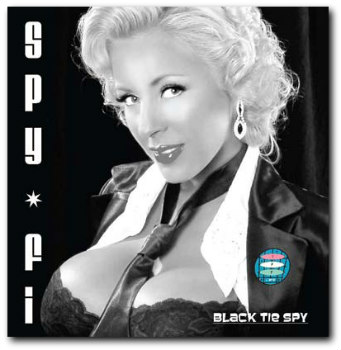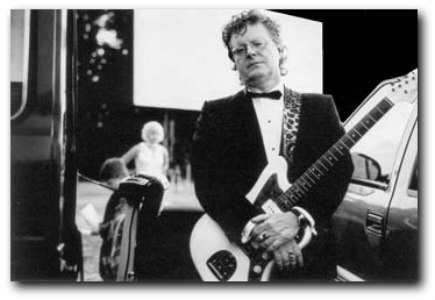
HOMEWesley Britton’s Books,
|
Spies on FilmSpies on Television & RadioSpies in History & LiteratureThe James Bond Files |
|
Spies on Film ~ A Spy Movie Without Pictures –
Inside the Instrumental Soundscape of Black Tie Spy
By Wesley Britton 
Kay O’Hara graces the cover of Black Tie Spy, the latest CD from Spy-Fi. A few years back, I interviewed Tom Pervanje for the first time for an article entitled “Spy Guitar – From Vic Flick to Spy-Fi.” In that conversation (posted at this website in The James Bond Files section), Bond guitarist Vic Flick shared some insights into his Bond work and Tom provided some very thoughtful analysis of the composers that had influenced his own work. He also talked about the musical themes that became an integral part of the espionage and detective genres on film and TV. Back then, Pervanje was the main motor and lead guitarist for Spy-Fi, a “Ventures”-like instrumental group that had issued two albums in 2004 – Spies, Thighs, and Private Eyes, volumes one and two. I reviewed both those CDs in “Spy Guitar” and continue to recommend them both to any fan of film themes and the California surf sound. Both albums are enjoyable mixes of covers of classic themes, original tunes, and interesting medleys. I’ve kept up with Tom ever since, and was delighted to learn about Spy-Fi’s new project – a concept album called Black Tie Spy. I was even more delighted to hear the finished album and was startled at the freshness and originality of the performances and continuity of the various m usical themes. Black Tie Spy very much sounds like a soundtrack to a film – but, of course, there’s no such movie. Here is what Tom said about the album in his press release:
Sound intriguing? I was knocked out by what I read and heard, so I decided to probe into Black Tie Spy a bit deeper and ask Tom a few questions. Below is the inside story of an album you shouldn’t miss: Q – What inspired you to create a concept album, something very different from your previous two collections? The first two volumes were a document of where the band was at that time. They were the blueprint for the Spy-Fi version of spy-detective music. There were about 7 originals on those works, which began to hint at the next step for the band. The current album concept was inspired by the John Barry soundtrack album for The Ipcress File, in which Michael Caine has short snippets of dialogue between tracks. Q – Black Tie Spy sounds very much like a soundtrack album for a movie – but, of course, there’s no film. Did you have a storyline in mind, visuals you had in your imagination that go along with the selections? I would love to tell you that I did, but no, there was no real storyline in mind when I started. I realized the opportunity to contrast and complement the moods of each song when it came time to assemble the final order of the tracks on the CD. This led me to create an aural landscape that would be experienced in real time as one progressed through it. That was a lot of fun, especially with the shorter “sketch” songs separating the longer more completed thoughts. That’s when the “visuals” for an order came to light. Q – Why did you choose a female lead character – and why the Russian spoken word clips from her? 
Kay O’Hara plays a Russian femme fatale in Black Tie Spy “Black Tie Spy” suggests a tuxedo; which suggests a male. I wanted to have fun with that idea, by turning it around. The cover photo of Kay O’Hara just underscored it in spades. As for Russian word clips. . . it all goes back to my first Bond movie at 14 years old, Thunderball. Fiona Volpe (Luciana Paluzzi) appeared to be Russian to me. I know now she’s Italian, but it didn’t matter. I thought she was Russian, and she was bad, very bad. And that was good, very good. Also, I had a mad crush on Boris Badinov’s Natasha. Just kidding – but I loved the way she talked: “Sneaky plan to get Moose and Squirrel.” So my Russian friend Alla helped me out with the Russian word clips. I wrote the copy, she edited it for Russian and read it. She thought I was silly of course, she had never heard of Boris and Natasha (she’s 21). So I had to show her on YouTube what that was all about. In the early 1960’s, when I was a young boy, that’s the only “Russian” input I had. And later Fiona Volpe came into my life and that was that. Okay, trivia time – if I’m not correct, please let me know, but I think Fiona Volpe is the only Bond girl to say “Mr. Bond, James Bond” directly to his face. It’s in the bedroom scene, check it out. Talk about a memory burn. Hubba hubba. Q – Speaking of 007, tell us about your collaboration with Vic Flick for the title track. What did he contribute alongside playing his guitar? Well, for starters Vic has been a great supporter of Spy-Fi, and a tremendous mentor. He’s given some great advice through the years, and I especially like hearing his opinions on the music we create. It’s an honor to have someone of his experience and stature giving input. In addition, he helped arrange and write the song “Soul Booker”. We also collaborated with him on “Black Tie Spy”, and as listed on the album, he tracked the fabulous guitar parts in the second half of the song. My favorite part of the song is the very end. It was my idea to suggest the James Bond Theme within the song and I dropped half of the one signature riff and then Vic came back with guitar parts on either side of my part. Admittedly, it’s a guitar player geek thing to be so concerned about it, but it means a lot to me to be on a record with Vic. Q – How did you choose the cover tracks and what were they intended to convey in your “soundscape”? “Perry Mason,” “Apache,” and “Rumble” don’t, at first glance, seem very “spyish.” Well, I suppose you’re correct. Spy-detective is the genre description I’ve used until now; but in fact I think “crime jazz” is another shade of the genre I’d like to explore more. So I think “Perry Mason” fits. “Apache” and “Rumble” admittedly aren’t within the scope. But my thought was that a movie soundtrack has a variety of moods, and I wanted some things to contrast with the song before or after it. Some scenes are violent, such as “Rumble,” and others are more romantic such as “Apache.” Plus “Apache” has a very special meaning for me. A good friend, Bob Capuano, drummer for Blue Taxi, visited me in July of 2007. He came over to fish in the small pond in my back yard. When it got dark, I said, “Hey, let’s go down and record “Apache” – I’m working on a version with a wah-wah pedal”. We put down three loose takes and called it a night. Sadly, Bob passed away three months later. He was suffering from mesothelioma, and it overtook him. His brother and my close friend, Bill Capuano, is a very accomplished guitar player with Blue Taxi and currently, with a band called The Extremes. We finished the song together in tribute to Bob. You can hear Bill playing acoustic guitar and the soaring lead. Bill appears on 9 of the 20 songs on Black Tie Spy and contributes some fantastic guitar playing. He’s featured especially on “Soul Booker,” “Sunset Beach,” “Fast Indian,” and the first guitar lead in “Perry Mason.” In fact, Bill and Bob are both extended family members of Spy-Fi. They both played at the last Spy-Fi gig in October 2006, when we opened for the Red Elvises in Cleveland. Q – Some of your titles seem to be Western oriented – “Fast Indian,” “El Dorado,” “Apache.” How do they connect to your Russian theme? That’s a great observation. We actually had a song called “Fistful of Mick” blocked out for this CD but could not get it finished in time. Obviously, a spaghetti western direction was subconsciously brewing. Maybe in my mind the soundscape went to “spaghetti espionage”?? I would have to say that I didn’t want all the songs to have such overt classic spy references. Think of the songs in Dr. No. The song titles and references were very Jamaican because of the script location. Maybe the Russian Black Tie Spy was in the secret hills of Utah or New Mexico investigating Area 51. Who knows? Q – The latter tracks have surf and soul themes. Was this a means to bring in different musical approaches? Yes. There are what I would call two “surf” inspired songs on the album, “Memory Burn” and “La Tavola Da Surf”. The latter means “surfboard” in Italian. Spy-Fi has always included surf/instro themes in its repertoire, and they both are tunes that are upbeat and danceable. Q – “Illya’s Theme” sounds like an homage to The Man From U.N.C.L.E. and “To JB” a reference to 007. What film spies did you have in mind? Right on the mark. Illya was such a cool name to me; and I really enjoyed MFU when I was a kid. In my mind, Illya was way cooler than Napoleon. “To JB”? That title does double duty: I was referencing James Bond of course, but also Jeff Beck, one of my guitar heroes. Q – I don’t know for sure – but the fact listeners have to go to your website to read the English translations of the Russian clips might be something brand new in music marketing. Why did you decide on this approach? Well, if you’ve noticed, I still refer to this work as an album. To me, it still is an album, a collection of songs. Yes, it’s in digital format (CD), but I was thinking that making someone go to the site would take the place of the physical album cover. Plus, it’s a bit of spy-detective work to find out what she’s saying! Q – You have a number of guest musicians on the CD which contributes to the range of musicality, at least in my opinion. How did you choose the players and what did they bring to the various tracks? Spy-Fi has grown to accept musicians that share the overall concept and appreciate the opportunity to create something new. All of the musicians are accomplished in their own right, and I was honored to play with each and every one of them. 
Thomas Pervanje with his Jazzmaster guitar. Of course, I mentioned Vic Flick and his contributions earlier. Scott Anderson, Bob Yeager and Mick Zofcin have been the core of the band for many years. But since we’re now separated in different parts of the country, it allows Spy-Fi to grow and explore newer directions and musical influences. But I can still keep the core members involved when they return to town and drop in for a session or two. Bill Capuano, whom I mentioned above, contributed significantly to the album. It was wonderful having a second guitar sound and a different approach to playing. Previously, I would double or triple track the guitars and honestly, was getting tired of hearing my own playing. So it was refreshing and invigorating to have new guitar sounds with which to work. I’ve always enjoyed playing with Bill because we work so well together. Hank Levine, the original Spy-Fi drummer from 1996, did such a great job on the jazzier tunes, and added great percussion to “Bass Case”. He had the studio filled with all kinds of cool percussion equipment, and I think he used every one! Drummer Denny Melreit dropped in one night and we put down the basics for “La Tavola Da Surf” in two takes. It just snapped together. Bob Rericha (mandolin) was teaching me jazz guitar lessons in 2007. He encouraged me to tackle such tunes as “Wave” and “Anitra’s Dance.” Who would have thought Edvard Grieg’s “Peer Gynt” would work in a crime jazz setting? Or for that matter, mandolin on a spy song (“Illya’s Theme”). But there you have it. Q – What’s next for Spy-Fi? Any projects in the pipeline? Currently I’m in the process of marketing the new CD. But there are a number of ideas in the can for the next album on which I could start working. I have three concepts that I’ve been tossing around: 1) trying some spy-electronica, similar to the version of “The Saint” that was popular a few years ago. 2) a more traditional soundtrack with a recurring theme in different and varying style of music and 3) a reissue of a classic 1968 spy-detective album. The latter is the least interesting, simply because it takes Spy-Fi back into cover material land and I’m not sure I want to go there again. Although I can say this about covers: each Spy-Fi album from here on out will contain one or two classic spy-detective songs on it. Some tunes we used to do that never made it to tape were “I Spy,” “You Only Live Twice,” “Ipcress File,” and “Our Man Flint” to name a few. I would still love to take a stab at those. I’d even like to have a guest female vocalist on “YOLT.” We’ll see what happens. Black Tie Spy is available through Amazon U.S. You may contact Tom Pervanje through his eMail address. |